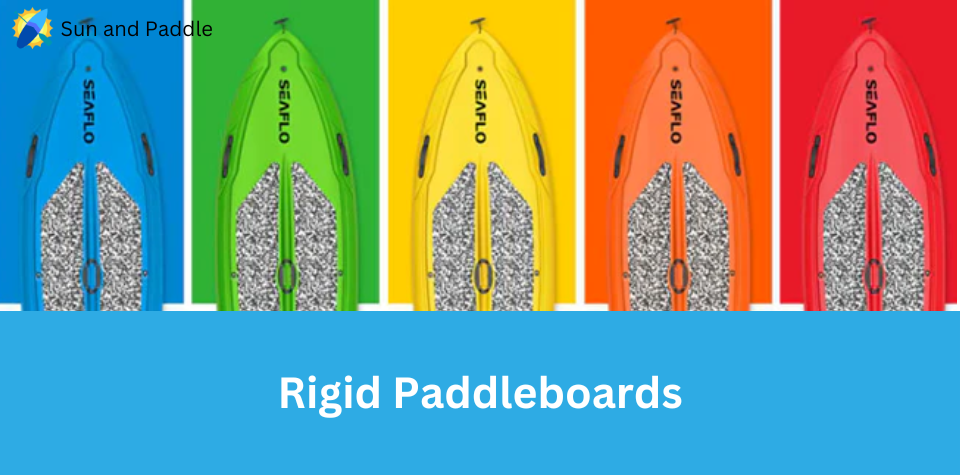Rigid paddleboards are not inflatable and are made of solid materials such as foam, fiberglass, or carbon fiber.
They offer a more stable and sturdy platform than inflatable paddleboards, making them ideal for a variety of activities such as paddlesurfing, yoga, and fishing. Plus, they tend to have better performance and glide through the water more efficiently.
If you’re considering purchasing a paddleboard, it’s important to understand the benefits of a rigid paddleboard over an inflatable one, as well as the different materials they can be made of and how to choose the right one for your needs.
In this article, we’ll explore all of these topics and more, so you can make an informed decision and get the most out of your stand-up paddleboarding experience.
Key Takeaways
- Rigid paddleboards offer greater stability and performance than inflatable ones.
- They can be made of various materials, including foam, fiberglass, and carbon fiber.
- When choosing a rigid paddleboard, consider your intended use and skill level to find the right one for you.
Benefits of Rigid Paddleboards over Inflatable
If you’re considering purchasing a paddleboard, you may be wondering whether to go for a rigid or inflatable model. While both have their advantages, there are several benefits to choosing a rigid paddleboard over an inflatable one.
Speed
One of the main advantages of a rigid paddleboard is its speed.
Rigid boards are generally faster than inflatables due to their sleeker design and lack of air resistance. This makes them ideal for longer paddles or for those looking to cover more distance in a shorter amount of time.
Stability
Another benefit of rigid paddleboards is their stability.
Rigid boards tend to be more stable than inflatables due to their solid construction and lack of flex. This can be especially important for beginners who are still learning to balance on the board.
Durability
Rigid paddleboards are also more durable than their inflatable counterparts.
While inflatables are prone to punctures and leaks, rigid boards are made from sturdy materials such as fiberglass or carbon fiber and are less likely to sustain damage. This means they can last longer and require less maintenance over time.
Safety
Rigid paddleboards are also considered safer than inflatables due to their solid construction.
Inflatable boards can be more prone to tipping or flipping, especially in choppy water or windy conditions. Rigid boards, on the other hand, are more stable and less likely to tip over, reducing the risk of injury.
Transport & Storage
While inflatables are often touted as being more convenient for transport and storage, rigid paddleboards can also be easy to transport and store with the right equipment.
Many rigid boards come with handles or straps for easy carrying, and can be stored on a wall rack or in a protective bag when not in use. Plus, you won’t have to worry about inflating and deflating your board every time you want to use it.
What Are Rigid Paddleboards Made Of?
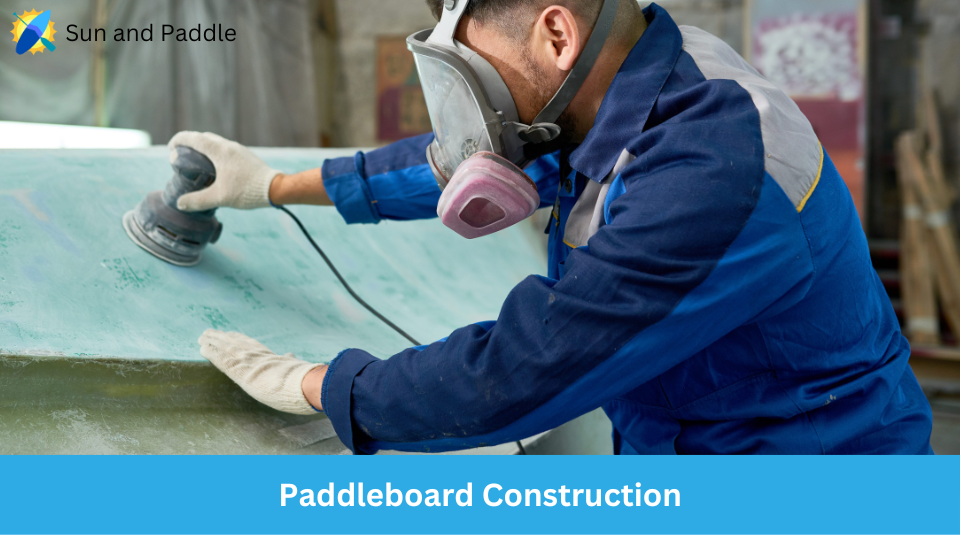
If you’re looking to purchase a rigid paddleboard, one of the first things you’ll want to consider is the material it’s made of. There are several different materials used in the construction of these boards, each with its own strengths and weaknesses. In this section, we’ll take a closer look at the most common paddleboard construction materials as well as a newer, more advanced option.
Most Common Paddleboard Construction
The majority of rigid paddleboards are made using a foam core with a fiberglass or epoxy resin coating.
The foam core provides buoyancy, while the outer layer of fiberglass or epoxy resin provides durability and protection against the elements.
This construction method is popular because it is relatively affordable and produces a lightweight, durable board that is suitable for a wide range of activities.
Carbon Fiber Over Foam Cores
For those looking for a more advanced paddleboard construction, carbon fiber over foam cores is becoming an increasingly popular option.
This construction method involves using a foam core, just like the traditional method, but instead of fiberglass or epoxy resin, a layer of carbon fiber is used.
This creates an incredibly lightweight and strong board that is perfect for racing or other high-performance activities.
While carbon fiber over foam cores are more expensive than traditional construction methods, they offer unparalleled performance and are often preferred by serious paddlers. They are also incredibly lightweight, making them easy to transport and maneuver.
Choosing a Rigid Paddleboard for SUP
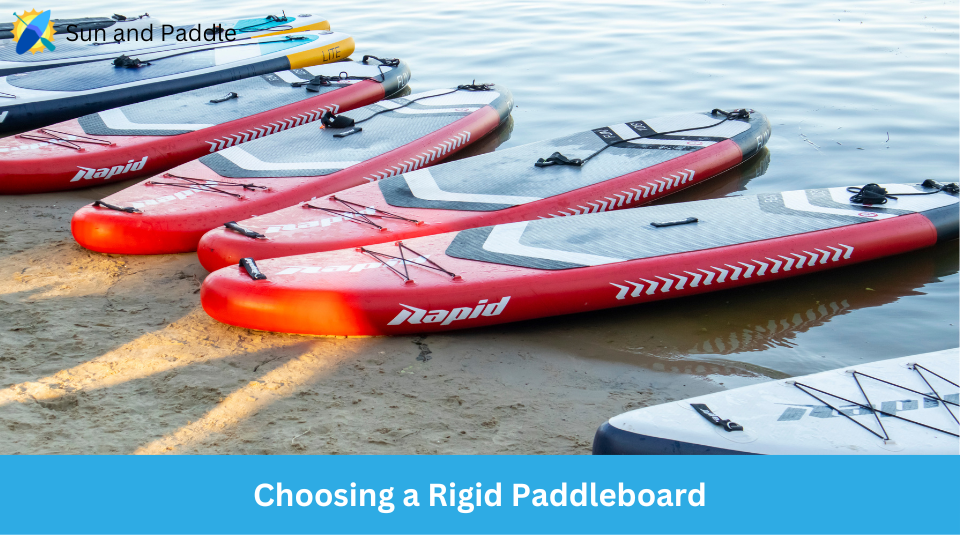
Once you decide to invest in a rigid paddleboard for SUP instead of an inflatable one, you still have to choose one based on how you use it. You can find several kinds of SUP boards. Each one is designed to be used for a specific type of activity and skill level.
All-around SUPs are for a broad range of activities, whether it’s flatwater paddling or SUP yoga. This has a rounded nose, and it’s the perfect board for beginners.
Another type of paddleboard is the touring board. This is intended for longer distances and is designed with a pointed nose that helps with gliding and efficiency. The touring SUP is longer and narrower compared to the all-around SUPs. This type of paddleboard is suitable for intermediate to advanced paddlers.
SUP surfboards, on the other hand, are shorter, and their rockers are more pronounced. They are known for being maneuverable, which makes them the best option for riding waves.
You can also find yoga/fitness SUPs. Such boards are wider in form. They offer more stability for on-water yoga sessions and workouts. In selecting an SUP, you have to consider the paddleboard’s width, length, and volume since these factors influence stability, weight capacity, and maneuverability.
Best Rigid Paddleboard for SUP: Surftech Catalyst Tuflite V-Tech
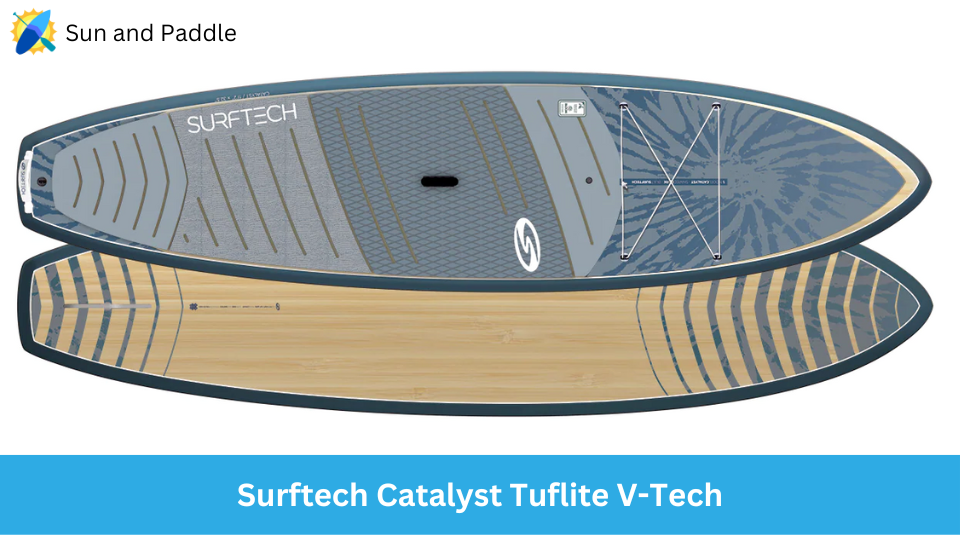 If you’re looking for a high-quality rigid paddleboard for SUP, the Surftech Catalyst Tuflite V-Tech is a great option.
If you’re looking for a high-quality rigid paddleboard for SUP, the Surftech Catalyst Tuflite V-Tech is a great option.
This board is designed for intermediate to advanced paddlers who want a fast and responsive board that can handle a variety of conditions.
The Surftech Catalyst Tuflite V-Tech is made from a lightweight and durable Tuflite V-Tech material that provides excellent stiffness and stability.
It also features a unique bottom contour that helps to improve speed and maneuverability, making it a great choice for racing or touring.
Other features of the Surftech Catalyst Tuflite V-Tech include a comfortable deck pad, multiple tie-down points for gear storage, and a convenient carry handle.
Choosing a Rigid Paddleboard for Paddle Surfing
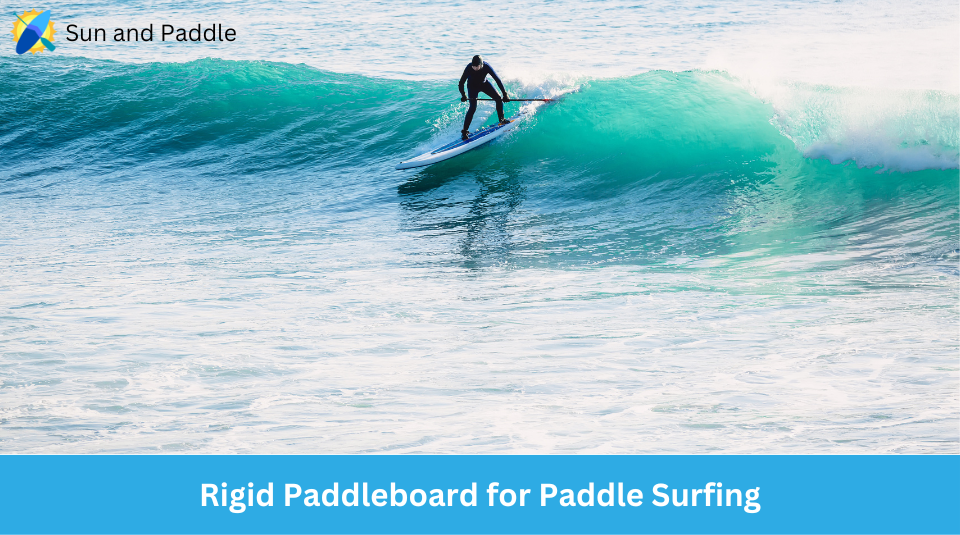
Before you decide on a particular paddle board to use for SUP surfing, you have to ask a couple of questions. First, among them is: is the shape of the board suitable for SUP surfing? If the main purpose of the board is surfing while you invest in another board for paddling purposes, then a surf-specific design is best for you. These boards are short and low-volume. The low volume of a surf-specific board helps one to perform better on some waves when the board skims over the surface of the water instead of relying on the board’s buoyancy. Some people opt for the all-around SUP boards. If this is picked carefully, it can be a great board for everyday paddling and still double as a surfing SUP.
How does the board’s fin setup help in my surf control? Indeed the shape and related dimensions of the board are major factors to consider when buying an SUP board; the fin setup allows you to tune or transform the paddle board’s performance.
A long center fin lets you create the least drag, and it works great on boards that are designed for surfing, specifically the hard boards. You may also add side fins alongside the central fin to be able to control the board’s tail when handrails are not available. Choosing the fins is primarily about your degree of comfort and preference. Do remember though, that large center fins are known for more hold, while the shorter center fins have a looser feel.
The third question to ask: is the deck pad good for surfing? In general, the quality and texture of the deck pad the board spells a huge difference in terms of traction and the feel of the board underfoot. If you’re planning to surf your SUP, it would be better for you to look for a board that has a contoured tail pad area and a raised rear edge. This will prevent the back foot from sliding off the board. This will also give you more leverage when you apply foot pressure. Choosing your first racing paddleboard might seem like a daunting task, but for most people the main concern will be to stay in budget and selecting a board that will last.
Best Rigid Paddleboard for Paddlesurfing: Quatro Carve Pro
The Quatro Carve Pro is a top-rated rigid paddleboard for paddlesurfing. It is known for its stability, maneuverability, and speed.
This board is designed for intermediate to advanced paddlers who want to take their skills to the next level.
Here are some key features of the Quatro Carve Pro:
- Length: 7’7″
- Width: 28.25″
- Volume: 92 liters
- Weight: 14.5 lbs
- Construction: Carbon Innegra
The Quatro Carve Pro is a high-performance board that is perfect for paddlesurfing in a variety of conditions. It is lightweight and easy to maneuver, making it ideal for carving turns and riding waves.
Keep in mind that there are many other rigid paddleboards on the market, so be sure to do your research and choose a board that meets your specific needs and preferences.
How to Choose a Rigid Paddleboard for Yoga
When choosing a paddleboard for yoga, it’s important to choose one that is wide and large enough to provide you with stability and comfort in trying new yoga poses. In general, an all-around paddleboard with all the necessary accessories will make a great versatile choice for yoga. The best yoga paddleboard comes with a three-fin setup. It must have a large center fin and two side fins that allow maximum water stability. Some of the accessories to have with your paddleboard for yoga include a coil leash, adjustable aluminum paddle, a pressure pump and SUP backpack (for iSUPs), and a dry bag for your keys and valuables.
If you can test paddle a couple of boards, grab the opportunity. Some many rental shops and retailers offer test paddles and also demo days for potential customers. A test paddle will allow you to get a feel of how each board feels when performing in the water.
Before buying a paddleboard for yoga or any type of paddling, you must consider its storage and transport. Make sure that you allot enough space at home for storing the board, and always invest in a good quality board. See to it as well that your transportation can accommodate a large board.
The warranty and customer support offered by the paddleboard manufacturer is another element to consider. Remember that a highly reputable and trustworthy manufacturer will be there to support their product by offering a comprehensive warranty to ensure that your investment will not be laid to waste.
Best Rigid Paddleboard for SUP Yoga: Pau Hana 10’ Moon Mist Yoga Paddle Board
Like any other SUP, the best yoga stand-up paddleboard meets all your requirements as a paddler and a yogi.
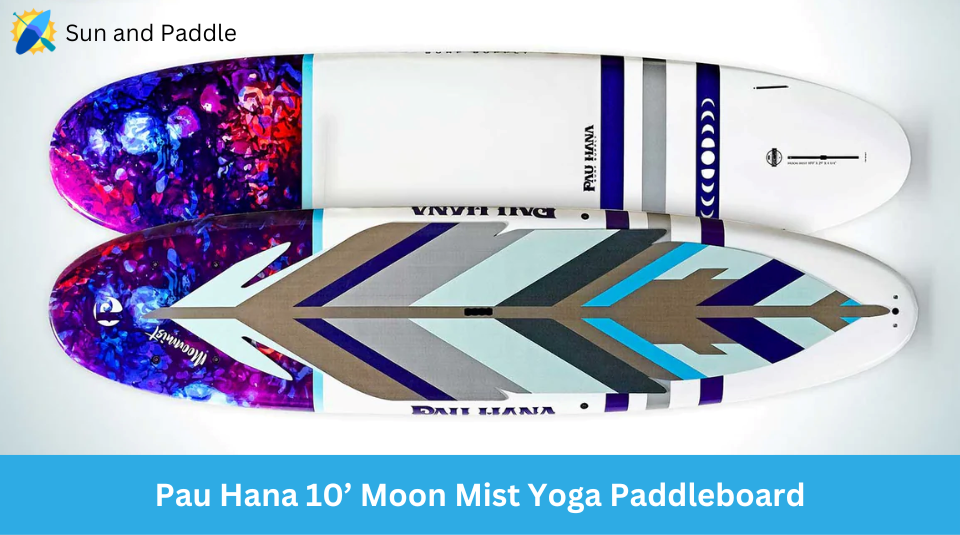
The Pau Hana 10’ Moon Mist Yoga Paddle Board is a great choice for those looking for a rigid paddleboard for SUP yoga.
This board is designed specifically for yoga and has a wide and stable platform, making it easy to perform yoga poses on the water. The deck pad is made of a soft and grippy material, providing excellent traction and comfort during your practice.
Size and Shape
When choosing a paddleboard for SUP yoga, size and shape are important considerations. You want a board that is wide and stable enough to provide a solid platform for your practice.
The Pau Hana 10’ Moon Mist Yoga Paddle Board is 34 inches wide, providing ample space for yoga poses.
Material
Rigid paddleboards are typically made of either fiberglass, carbon fiber, or wood.
Fiberglass boards are lightweight and durable, while carbon fiber boards are even lighter and more rigid. Wood boards are heavier but offer a classic look and feel.
The Pau Hana 10’ Moon Mist Yoga Paddle Board is made of fiberglass, making it both lightweight and durable.
Deck Pad
The deck pad is an important consideration when choosing a paddleboard for SUP yoga.
You want a pad that is soft and grippy, providing excellent traction and comfort during your practice. The Pau Hana 10’ Moon Mist Yoga Paddle Board has a soft and grippy deck pad that is perfect for yoga.
How to Choose a Rigid Paddleboard for Fishing
The best paddleboard for fishing must have a 4-layer PVC construction. Any paddleboard that is less than two layers is a disaster that is about to unfold. It should also have a removable center fin and a US-Style fin box. This will enable you to easily replace the center fin from various providers. The paddleboard for SUP must also have a flat bottom. This will make sure that it can function as a stable platform for SUP fishing, allowing you to catch fish wherever you may go to fish. The paddleboard for fishing must also be longer, aside from having a flat bottom. In such a shape, the paddleboard can provide more stability and offer more deck room for extra gear, more d rings, gear mounts, and sometimes even a huge deck cooler.
Best Rigid Paddleboard for Fishing: Pau Hana Endurance XL
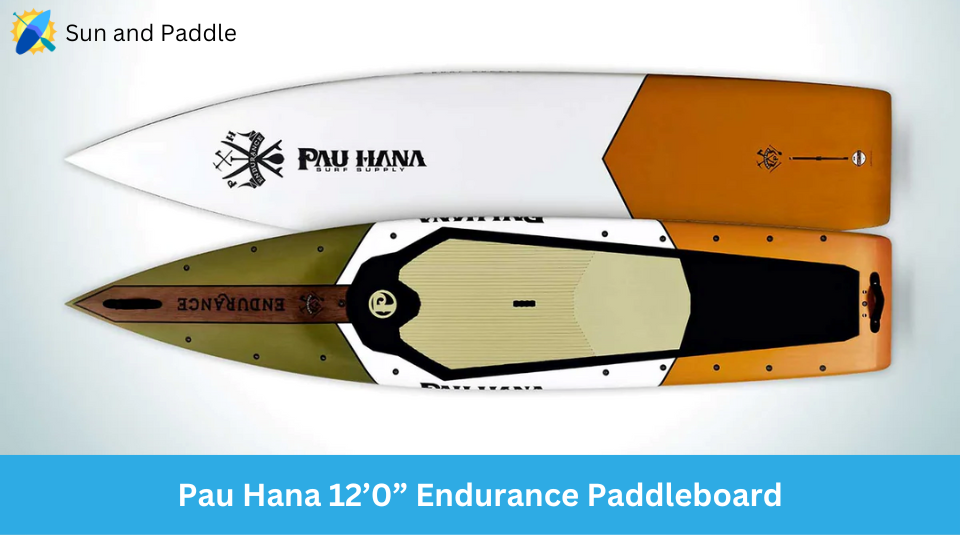
If you’re looking for the best rigid paddleboard for fishing, the Pau Hana Endurance XL is a great choice.
This board is designed specifically for fishing and has all the features you need to make your fishing trip a success.
The Pau Hana Endurance XL is 12′ long and 34″ wide, providing plenty of stability for fishing. It has a weight capacity of 450 pounds, so you can bring all your gear without worrying about overloading the board.
One of the best features of the Pau Hana Endurance XL is the built-in cooler.
This cooler is perfect for storing your catch or keeping your drinks cold while you’re out on the water. The board also has multiple tie-down points, so you can secure your gear and keep it from sliding around.
Another great feature of the Pau Hana Endurance XL is the flip-up seat.
This seat provides a comfortable place to sit while you’re fishing and can be flipped up to reveal a storage compartment underneath. This compartment is perfect for storing your tackle or other small items.
There are many more considerations when choosing the best fishing paddleboard for you. Take a look at some of our recommendations and more tips.
Popular Rigid Stand-UP Paddleboards
You can have numerous options for the best SUP paddle boards. Some of the top manufacturers of paddle boards include Boardwalks, Pau Hana, Isle, Surftech, and many others. It would be best to review various paddleboards in terms of performance, stability, durability, ease of transport, maneuverability, and the overall value of each board in different conditions, regardless if you’re a beginner or a pro.
Wavestorm 9ft6 Stand Up Paddleboard
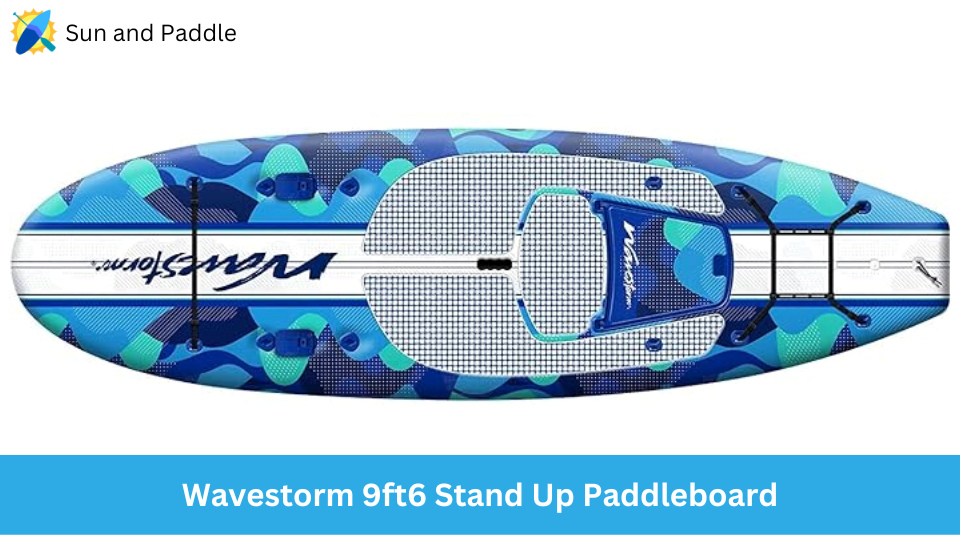
The Wavestorm Stand-Up Paddleboard is a popular choice for beginners due to its affordability and durability.
It is made of high-quality materials that ensure it can withstand wear and tear. The board is lightweight and easy to maneuver, making it perfect for those who are new to the sport. It also comes with a traction pad that provides a comfortable grip for your feet.
Isle Versa 2.0 Stand-Up Paddleboard
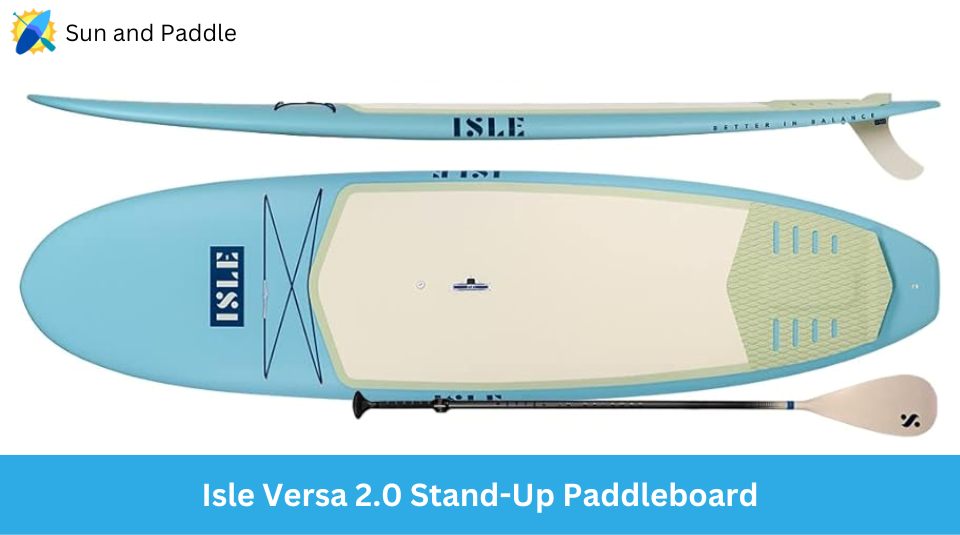
The Isle Versa 2.0 Stand-Up Paddle Board is designed for versatility and is suitable for all skill levels.
It is made of high-density foam and has a fiberglass shell that provides excellent durability. The board is easy to maneuver and is perfect for cruising on calm waters. It also comes with a bungee system that allows you to carry your gear with ease.
Hobie Heritage Stand-Up Paddleboard
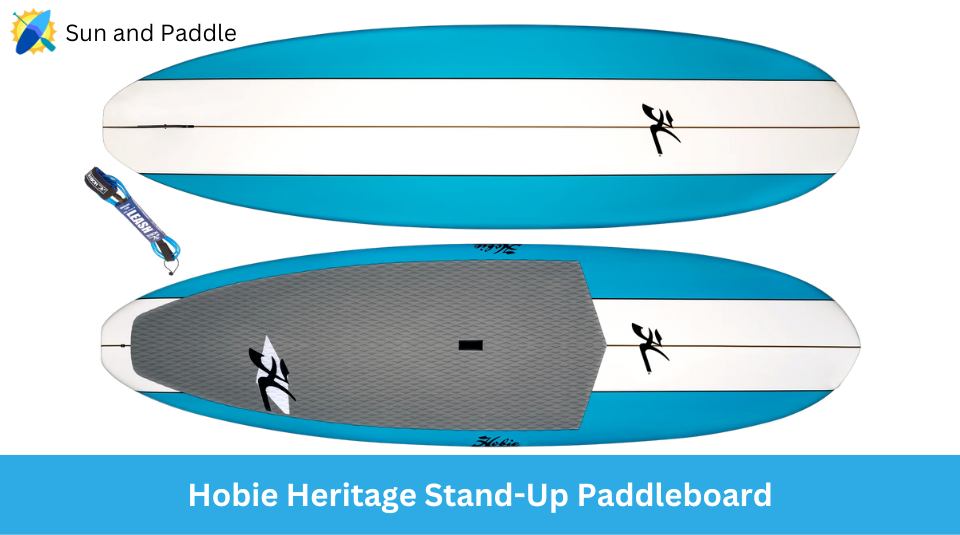
The Hobie Heritage is a classic board that is designed for stability and performance. It is made of high-quality materials that ensure it can withstand wear and tear.
The board has a wide nose that provides excellent stability, making it perfect for beginners. It also has a sleek design that allows it to glide smoothly through the water.
Lifetime Fathom 10 Stand-Up Paddleboard
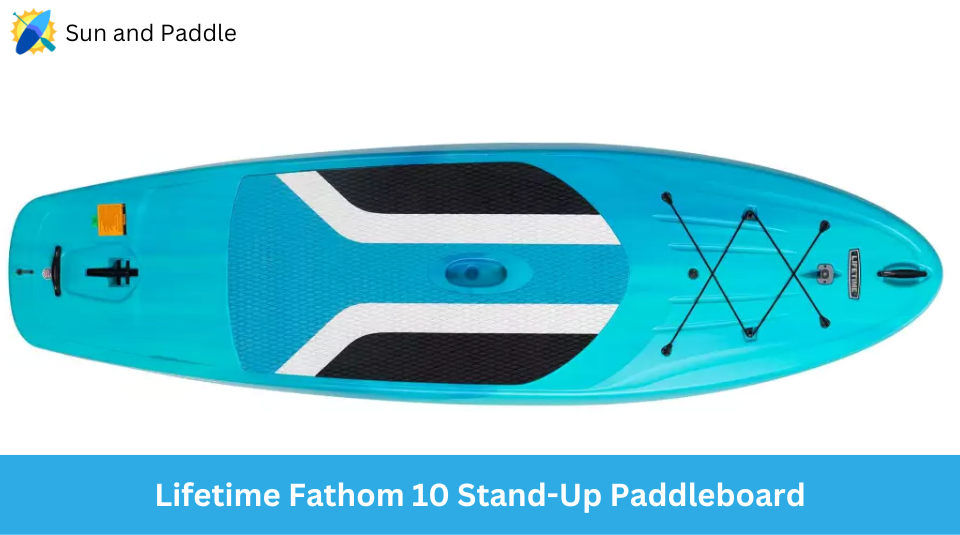
The Lifetime Fathom 10 Stand-Up Paddleboard is designed for stability and is perfect for beginners. It is made of high-density polyethylene that provides excellent durability.
The board has a wide nose and tail that provide excellent stability, making it easy to balance on. It also has a comfortable deck pad that provides a cushioned grip for your feet.
Pelican Flow 106 Paddleboard
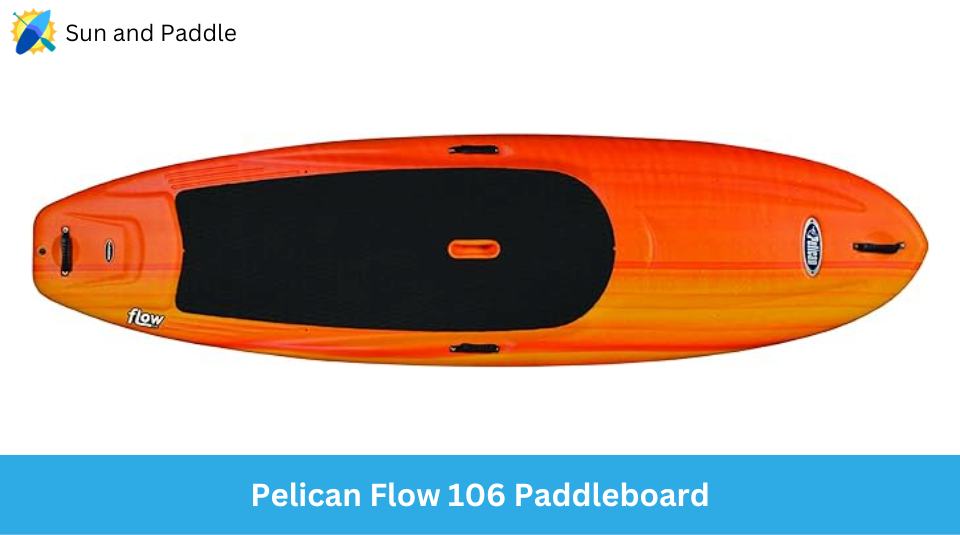
The Pelican Flow 106 Paddle Board is designed for stability and is perfect for beginners. It is made of high-quality materials that ensure it can withstand wear and tear.
The board has a wide nose and tail that provide excellent stability, making it easy to balance on. It also has a comfortable deck pad that provides a cushioned grip for your feet. The board is lightweight and easy to maneuver, making it perfect for those who are new to the sport.
How to Store a Rigid Paddleboard
When it comes to storing your rigid paddleboard, there are a few things you should keep in mind to ensure that it stays in good condition and is ready for your next adventure. Here are some tips on how to store your paddleboard:
On a Rack
Storing your paddleboard on a rack is a great option if you have limited space. Make sure the rack is designed specifically for paddleboards and is sturdy enough to support the weight of your board.
When placing your board on the rack, make sure it is level and not leaning to one side. This will prevent warping and ensure that your board stays in good condition.
Suspended
If you have a garage or other space with high ceilings, suspending your paddleboard can be a great option. You can use a pulley system to lift the board up and out of the way, freeing up valuable floor space.
Make sure the pulley system is secure and can support the weight of your board.
Leaning
Leaning your paddleboard against a wall is another option, but it’s important to do it correctly. Make sure the board is leaning at an angle and not straight up and down, as this can cause warping.
You can also use foam padding to protect the board and prevent it from slipping.
Storage Tips
No matter how you choose to store your paddleboard, there are a few general tips you should keep in mind:
- Store your board out of direct sunlight and away from heat sources.
- Keep your board dry and clean before storing it.
- If you’re storing your board for a long period of time, consider removing the fins to prevent damage.
- Check your board periodically to make sure it’s still in good condition and hasn’t warped or developed any cracks.
Frequently Asked Questions
What are the advantages of a rigid SUP over an inflatable one?
A rigid stand-up paddleboard (SUP) offers greater stability and durability compared to an inflatable one. Rigid paddleboards are more rigid and sturdy, which allows for better performance and speed. They also tend to have a longer lifespan than inflatable paddleboards.
How do I choose the best rigid paddle board for my needs?
When choosing a rigid paddleboard, consider your skill level, intended use, and personal preferences. Factors such as board length, width, and shape can affect stability, speed, and maneuverability.
It is also important to consider the weight capacity and construction materials of the board.
Why do hard shell paddle boards tend to have a higher price point?
Hard shell paddleboards are typically made of higher quality materials and require more labor-intensive manufacturing processes, which can drive up the cost. Additionally, the durability and performance of a rigid paddleboard make it a worthwhile investment for serious paddlers.
What should I consider when looking for a lightweight hard paddle board?
When searching for a lightweight hard paddleboard, consider materials such as carbon fiber or fiberglass, which are both strong and lightweight.
Additionally, look for boards with a streamlined design and minimal extras, as these can add unnecessary weight.
Where can I find high-quality used hard paddle boards for sale?
High-quality used hard paddleboards can be found through online marketplaces, local paddleboard shops, and rental companies. Be sure to inspect the board thoroughly before purchasing to ensure it is in good condition.
What are the key differences between solid and inflatable paddle boards?
The main difference between solid and inflatable paddleboards is their construction.
Solid boards are made of hard materials such as fiberglass or carbon fiber, while inflatable boards are made of PVC or other durable materials.
Inflatable boards are generally more portable and easier to store, while solid boards offer better performance and durability.

